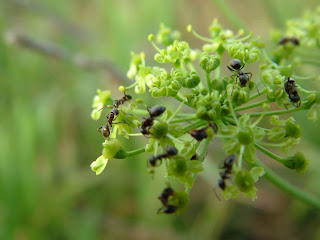Considering the Ant
 |
| morgueFile/jak |
Have you ever seriously considered what they are doing, and how they do it? The spill on your kitchen floor that you thought you had cleaned up, or planned on getting to later — they found it, and told their friends. How? And when they're carrying some dead thing in their caravan, what's up with that?
You can follow the trail and continue reading "Ants — Millimeter Messengers", here.Ants have taken over the world, it seems, but they didn’t do it alone! One reason they’re so successful is their ability to communicate with each other—where to go, what to watch out for, how to help.The lone ant follows the path marked earlier by her companions. In her ceaseless search for food, she decides to veer off the trail and blaze a new path. Along the way, she releases a complex cocktail of chemicals to assure that, if her hunt is successful, other ants can locate her trail and lend a leg (or jaw).Finding no sustenance, she hightails back to the trail junction and leaves another sign for her nest mates: “dead end.”She tries another route, and this time she stumbles onto a live giant caterpillar that would feed many in her family. But it is too big to handle alone. Firing a dazzling array of chemicals into the air, like sounding a trumpet in the heat of battle, she summons reinforcements who soon arrive. Not only do they know how to find her but they also bring the necessary tools and personnel to kill the caterpillar and bring the body back to their nest.